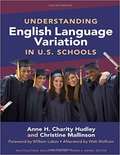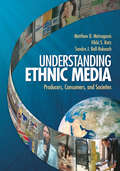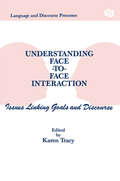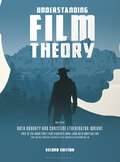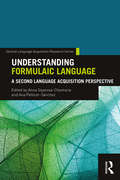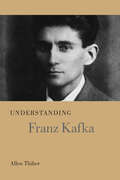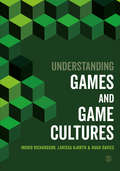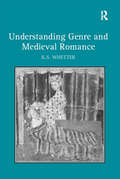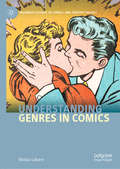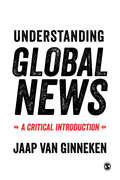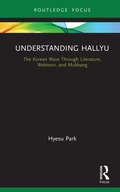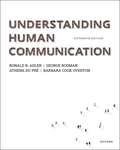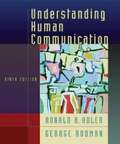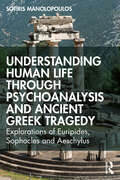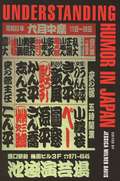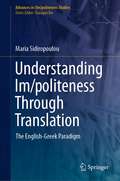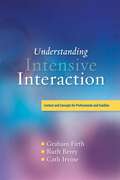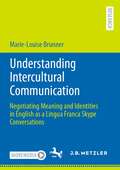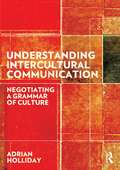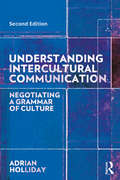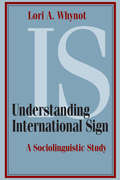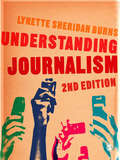- Table View
- List View
Understanding English Language Variation In U. S. Schools
by James A. Banks Christine Mallinson Anne H. Charity HudleyIn today’s classrooms, students possess and use many culturally, ethnically, and regionally diverse English language varieties that may differ from standardized English. This book helps classroom teachers become attuned to these differences and offers practical strategies to support student achievement while fostering positive language attitudes in classrooms and beyond. The text contrasts standardized varieties of English with Southern, Appalachian, and African American English varieties, focusing on issues that are of everyday concern to those who are assessing the linguistic competence of students.
Understanding Ethnic Media: Producers, Consumers, and Societies
by Matthew D. Matsaganis Vikki S. Katz Sandra Ball-RokeachThis is the first book to provide a comprehensive review and analysis of how media produced by ethnic communities, and for ethnic communities, affect identity and perceived lines of division between "us" and "others," as well as how the production and consumption of ethnic media affect the character of the larger media and societal landscapes. Integrating key ethnic media studies with original research, this book makes a unique contribution by covering both consumers and producers of ethnic media, as well as the history of ethnic media, its role in ethnic communities, the effect of globalization, and the professional challenges faced by ethnic media journalists. A compelling discussion on the future of ethnic media concludes the book and points the way toward further research.Key Features:A fresh viewpoint: The book focuses on how and why ethnic and racial minorities produce and consume media for themselves—not just how they are represented in or by the media.An ecological approach: The authors explore the growth of ethnic media in different socio-political contexts and approach ethnic media from the vantage points of both the audience and the media organization.An international focus: Provides readers with comparative examples from around the world.A conceptual and practical focus: Conceptual content is relevant, timely, and connected to readers′ lived experiences through real-world case studies.A student-friendly presentation: In each chapter, introductory bullet points identify the main concepts and issues, key terms are defined, student projects are suggested, and discussion questions are provided.
Understanding Face-to-face Interaction: Issues Linking Goals and Discourse (Routledge Communication Series)
by Karen TracyChallenging current work in communication and social psychology that assumes face-to-face interaction can be adequately understood without attending to discourse expression, this volume examines how people's goals, concerns, and intentions can be related to discourse expression. The text discusses discourse-goal linkages in specific face-to-face encounters such as courtroom exchanges, marital counseling, and intellectual discussions, as well as in more general theoretical dilemmas. Because it poses a new set of questions about social actors' motivations and pre-interactional goals, this volume offers a new direction for discourse study -- one that seriously considers the thinking and strategy involved in human communication.
Understanding Film Theory
by Ruth Doughty and Christine Etherington-WrightThis essential core textbook provides an approachable and extensive introduction to film theory, written by two highly experienced senior lecturers. Bringing a fresh, contemporary and accessible approach to what is often perceived to be a challenging and old-fashioned area of film studies that requires time and effort to grasp, the text illustrates why theory is important and demonstrates how it can be applied in a meaningful way. The book's sixteen chapters are clear and comprehensive and provide an insight into the main areas of debate, using clear definitions and explaining complex ideas succinctly. <P><P> The ideal entry point for any student studying film, the book is designed for use on courses on film theory on undergraduate and postgraduate degree programmes within film, cinema, media and cultural studies.
Understanding Formulaic Language: A Second Language Acquisition Perspective (Second Language Acquisition Research Series)
by Ana Pellicer-Sánchez Anna Siyanova-ChanturiaUnderstanding Formulaic Language: A Second Language Acquisition Perspective brings together leading scholars to provide a state-of-the-art, interdisciplinary account of the acquisition, processing, and use of formulaic language. Contributors present three distinct but complementary perspectives on the study of formulaic language – cognitive/psycholinguistic, socio-cultural/pragmatic, and pedagogical – to highlight new work as well as directions for future work. This book is an essential resource for established researchers and graduate students in second language acquisition and pedagogy, corpus and cognitive linguistics, psycholinguistics, sociolinguistics, and pragmatics.
Understanding Franz Kafka (Understanding Modern European and Latin American Literature)
by Allen ThiherAn analysis of the life of the eccentric author of The Trial, and his quest for meaning in his work.Franz Kafka is without question one of the most influential writers of the twentieth century despite the fact that much of his work remained unpublished when he died at a relatively young age in 1924. Kafka’s eccentric methods of composition and his diffident attitude toward publishing left most of his writing to be edited and published after his death by his literary executor, Max Brod.In Understanding Franz Kafka, Allen Thiher addresses the development of Kafka’s work by analyzing it in terms of its chronological unfolding, emphasizing the various phases in Kafka’s life that can be discerned in his constant quest to find a meaning for his writing. Thiher also shows that Kafka’s work, frequently self-referential, explores the ways literature can have meaning in a world in which writing is a dubious activity.After outlining Kafka’s life using new biographical information, Thiher examines Kafka’s first attempts at writing, often involving nearly farcical experiments. The study then shows how Kafka’s work developed through twists and turns, beginning with the breakthrough stories “The Judgment” and “The Metamorphosis,” continuing with his first attempt at a novel with Amerika, and followed by Kafka’s shifting back and forth between short fiction and two other unpublished novels, The Trial and The Castle.Thiher also calls on Kafka’s notebooks and diaries to help demonstrate that he never stopped experimenting in his attempt to find a literary form that might satisfy his desire to create some kind of transcendental text in an era in which the transcendent is at best an object of nostalgia or of comic derision. In short, Thiher contends, Kafka constantly sought the grounds for writing in a world in which all appears groundless.
Understanding Games and Game Cultures
by Larissa Hjorth Ingrid Richardson Hugh DaviesDigital games are one of the most significant media interfaces of contemporary life. Games today interweave with the social, economic, material, and political complexities of living in a digital age. But who makes games, who plays them, and what, how and where do we play? This book explores the ways in which games and game cultures can be understood. It investigates the sites, genres, platforms, interfaces and contexts for games and gameplay, offering a critical overview of the breadth of contemporary game studies. It is an essential companion for students looking to understand games and games cultures in our increasingly playful and ‘gamified’ digital society.
Understanding Games and Game Cultures
by Larissa Hjorth Ingrid Richardson Hugh DaviesDigital games are one of the most significant media interfaces of contemporary life. Games today interweave with the social, economic, material, and political complexities of living in a digital age. But who makes games, who plays them, and what, how and where do we play? This book explores the ways in which games and game cultures can be understood. It investigates the sites, genres, platforms, interfaces and contexts for games and gameplay, offering a critical overview of the breadth of contemporary game studies. It is an essential companion for students looking to understand games and games cultures in our increasingly playful and ‘gamified’ digital society.
Understanding Genre and Medieval Romance
by K.S. WhetterUnique in combining a comprehensive and comparative study of genre with a study of romance, this book constitutes a significant contribution to ongoing critical debates over the definition of romance and the genre and artistry of Malory's Morte Darthur. K.S. Whetter offers an original approach to these issues by prefacing a comprehensive study of romance with a wide-ranging and historically diverse study of genre and genre theory. In doing so Whetter addresses the questions of why and how romance might usefully be defined and how such an awareness of genre-and the expectations that come with such awareness-impact upon both our understanding of the texts themselves and of how they may have been received by their contemporary medieval audiences. As an integral part the study Whetter offers a detailed examination of Sir Thomas Malory's Le Morte Darthur, a text usually considered a straightforward romance but which Whetter argues should be re-classified and reconsidered as a generic mixture best termed tragic-romance. This new classification is important in helping to explain a number of so-called inconsistencies or puzzles in Malory's text and further elucidates Malory's artistry. Whetter offers a powerful meditation upon genre, romance and the Morte which will be of interest to faculty, graduate students and undergraduates alike.
Understanding Genres in Comics (Palgrave Studies in Comics and Graphic Novels)
by Nicolas LabarreThis book offers a theoretical framework and numerous cases studies – from early comic books to contemporary graphic novels – to understand the uses of genres in comics. It begins with the assumption that genre is both frequently used and undertheorized in the medium. Drawing from existing genre theories, particularly in film studies, the book pays close attention to the cultural, commercial, and technological specificities of comics in order to ground its account of the dynamics of genre in the medium. While chronicling historical developments, including the way public discourses shaped the horror genre in comics in the 1950s and the genre-defining function of crossovers, the book also examines contemporary practices, such as the use of hashtags and their relations to genres in self-published online comics.
Understanding Global News: A Critical Introduction
by Dr Jaap Van GinnekenA lively and critical introduction to the news media, this book has been written specifically for media students and trainee journalists. Understanding Global News invites the reader to explore contemporary journalistic practice, and questions the assumption that the media provide a mere window on the world. Challenging the often unquestioned notions of media objectivity, the author turns the classic questions: Who? What? When? and Why? onto the news media. By employing a range of theoretical perspectives and a large variety of examples, the author demonstrates the way in which our perceptions of the world are constructed by the news media.
Understanding Hallyu: The Korean Wave Through Literature, Webtoon, and Mukbang
by Hyesu ParkThis book sheds light on aspects of the Korean Wave and Korean media products that are less discussed—Korean literature, webtoon, and mukbang. It explores the making of these Korean popular cultural products and how they work and engage media recipients regardless of their different national, cultural, and geographical backgrounds. Drawing on narrative theory and cultural studies, the book makes a compelling argument about how to analyze the production and consumption of Korean media within and beyond its national boundary with critical eyes. The author shows how transmedial narrative studies (narrative studies across media) offers analytical and theoretical lenses through which one can interpret new and emerging media forms and contents. Furthermore, she explores how these forms and contents can be better understood when they are contextualized within specific time and place using the cultural, social, and political concepts and precepts of the region. The volume will be of great interest to scholars and researchers of Asian Studies, popular culture, contemporary cyberculture, media and culture studies, and literary theory.
Understanding Health Care in America: Culture, Capitalism, and Communication
by Michael PaganoThis book examines the current state of American health care using a social science lens to focus on the interdependent, intercultural, economic, and communication aspects of access and delivery. This text explores how the cultures of health care organizations, health professions, governments, and capitalism, as well as communication, all contribute to a disease-focused, economically driven, technology-centered health care system. It seeks to understand 21st century health care from a macro-level view based on historical realizations and the current plethora of interdependent, but self-serving realities that provide few, if any, incentives for organizational collaboration and change. The fact that the most expensive health care system in the world does not provide the healthiest outcomes is a driving force in this exploration. By reflecting on American values and beliefs regarding health care from philosophical, clinical, communication, and cost perspectives, this text is designed to encourage an organizational transformation at every level, from government to providers to patients. This comprehensive survey is an important guide for those studying, or working in, health care professions, as well as health care policy and administration. It should also be of interest to any reader who seeks to better understand U.S. health care policy from social science, economic, and/or health communication perspectives.
Understanding Human Communication
by Ronald B. Adler George Rodman Copy Barbara Cook Overton Athena du PrÃUnderstanding Human Communication addresses students' perception that they already know how to communicate--an issue faced by every faculty member. By artfully weaving cutting-edge academic research and theory into the clear, down-to-earth, and student-friendly narrative, the authors help students understand the complexity and depth of human communication and public speaking. The series of concepts builds logically through the chapter sequence, enabling students to further deepen their communication skills as they progress through the book. By accessing the text's integrated digital resources--contemporary and brief video clips; tutorials; and self-assessments---students will be able to see concepts applied in real scenarios, making their learning more meaningful.
Understanding Human Communication (Ninth Edition)
by Ronald B. Adler George RodmanWith its comprehensive classroom supplements, and dedicated student-focused pedagogy, this book continues to enliven classrooms and equip students with effective communication skills that will make a difference in their everyday lives.
Understanding Human Communication Twelfth Edition
by Ronald B. Adler George Rodman Athena Du PreFor over three decades, this has been the bestselling text for the Human Communication course. Understanding Human Communication is written with one goal in mind: to provide students with the insights and skills to succeed in our changing world. Fully updated and expanded to include more information on culture and communication, gender and communication, and the effects of technology and social media on communication, this twelfth edition also features two new types of boxes, "Understanding Diversity" and "@Work," as well as new annotated sample speeches.
Understanding Human Life through Psychoanalysis and Ancient Greek Tragedy: Explorations of Euripides, Sophocles and Aeschylus
by Sotiris ManolopoulosDrawing parallels between ancient theatre, the analytic setting, and the workings of psychic life, this book examines the tragedies of Euripides, Sophocles, and Aeschylus through a psychoanalytic lens, with a view of furthering the reader’s understanding of primitive mental states.What lessons can we learn from the tragic poets about psychic life? What can we learn about psychoanalytic work from ancient tragedy and playwrights? Sotiris Manolopolous considers how the key tenets of ancient Greek theatre – passion, conflict, trauma, and tragedy – were focussed on because they could not be spoken of in daily life and how these restraints have continued into contemporary life. Throughout, he considers how theatre can be used to stage political experiences and shows how these experiences are a vital part of understanding an analysand within an analytic setting. Drawing on his own clinical practice, Manolopoulos considers what ancient playwrights might teach us about early, uncontained agonies of annihilation and primitive mental states that manifest themselves both within the individual and the collective experience of contemporary life, such as climate change denial and totalitarian politicians.Drawing on canonical works such as Hippolytus, Orestes, Antigone, and Prometheus Unbound, this book continues the legacy of research that shows how contemporary analysts, students, and scholars can learn from ancient Greek literature and apply it directly to those negatively impacted by the trauma of 21st-century life and politics.
Understanding Humor in Japan
by Jessica Milner DavisJapanese conventions about comedy and laughter are largely unanalyzed. For many students of Japanese culture and visitors to Japan, Japanese humor seems obscure, incomprehensible, paradoxical, and even nonexistent. By bringing together scholarly insights and original research by both Japanese and non-Japanese experts, Jessica Milner Davis bridges the differences between humor in Japan and the West and examines the entire spectrum of Japanese humor, from ancient traditions and surviving rituals of laughter to norms of joke-telling in ordinary conversation in Japan and America. For anyone interested in Japan, Japanese culture, and humor studies, Understanding Humor in Japan is an important teaching tool. It provides accessible, illustrative examples of humor in both Japanese and English with explanations of their meaning and cultural significance. Scholarly yet readable, these essays offer intelligent discussion on such topics as the Japanese delight in wordplay, the comic content of Japanese newspapers, the role of film and television in developing Japanese stand-up comedy, and formal censorship and its impact on humorous writing and self-expression in Japan. Understanding Humor in Japan breaks new ground in the study of humor and sheds light on much that is taken for granted about the role of laughter in civilized societies.
Understanding Im/politeness Through Translation: The English-Greek Paradigm (Advances in (Im)politeness Studies)
by Maria SidiropoulouThis book offers a unique window to the study of im/politeness by looking at a translation perspective, which offers a different set of data and allows further understanding of the phenomenon. In the arena of real-life translation practice, the workings of im/politeness are renegotiated in a different cultural context and thus pragmatically oriented cross-cultural differences become more concrete and tangible. The book focuses on the language pair English and Greek, a strategic choice with Greek as a less widely spoken language and English as a global language. The two languages also differ in their politeness orientation in certain genres, which allows for a fruitful comparison. The volume focuses on press translation first, then translation of academic texts and translation for the stage, and finally audiovisual translation (mainly subtitles). These genres highlight a public, an interactional, and a multimodal dimension in the workings of im/politeness.
Understanding Intensive Interaction
by Graham Firth Ruth Berry Cath IrvineIntensive interaction is a valuable approach, with the potential to radically enhance the well-being of difficult-to-reach individuals, such as those with profound and severe learning disabilities, autistic spectrum conditions and emotional problems. This highly accessible book will help families and professionals develop a deeper understanding of this highly-successful approach and its associated issues, resulting in improved communication opportunities within a variety of care, therapeutic and educational settings. This compendium offers a multidisciplinary perspective to intensive interaction, bringing together the authors' experience and research from different disciplines. A glossary format and thematic structure are employed to enable readers to quickly access topics of interest, and gradually build on their understanding of the approach. Each chapter is devoted to an over-arching concept - including psychological theories of human behaviour, relationship building and maintenance and social inclusion - and illustrated with case studies to support theoretical assertions and offer practical examples of useful techniques. A useful reference and reflective tool, this book will interest both family and professional carers, support staff, special education teachers, learning disability nurses, social services practitioners, speech and language therapists, clinical psychologists, occupational therapists, or anyone who is interested in intensive interaction and wants to learn more.
Understanding Intercultural Communication: Negotiating Meaning and Identities in English as a Lingua Franca Skype Conversations
by Marie-Louise BrunnerToday, academics, business professionals and private persons alike need to communicate successfully and establish relationships with people from various cultures through digital means. These skills have now become essential in virtual environments. This book provides an in-depth analysis of how interlocutors negotiate meaning and identities in intercultural video-mediated communication as an important step to improving interactions on a global scale. It contributes to understanding the complex negotiation processes and strategies involved in communicating successfully and in establishing rapport in an intercultural and video-mediated context. Speakers in this English as a Lingua Franca setting act as accomplished conversationalists who efficiently employ various strategies to make themselves understood and to preempt interactional difficulties. At the same time, interlocutors (re)negotiate identities on various levels in the process of their interactions with conversation partners. Based on these insights, this book concludes with practical suggestions for educational and professional applications.
Understanding Intercultural Communication: Negotiating a Grammar of Culture
by Adrian HollidayIn this book, Adrian Holliday provides a practical framework to help students analyse intercultural communication. Underpinned by a new grammar of culture developed by Holliday, this book will incorporate examples and activities to enable students and professionals to investigate culture on very new, entirely non-essentialist lines. This book will address key issues in intercultural communication including: the positive contribution of people from diverse cultural backgrounds the politics of Self and Other which promote negative stereotyping the basis for a bottom-up approach to globalization in which Periphery cultural realities can gain voice and ownership Written by a key researcher in the field, this book presents cutting edge research and a framework for analysis which will make it essential reading for upper undergraduate and postgraduate students studying intercultural communication and professionals in the field.
Understanding Intercultural Communication: Negotiating a Grammar of Culture
by Adrian HollidayUnderstanding Intercultural Communication provides a practical framework to help readers to understand intercultural communication and to solve intercultural problems. Each chapter exemplifies the everyday intercultural through ethnographic narratives in which people make sense of each other in home, work and study locations. Underpinned by a grammar of culture developed by the author, this book addresses key issues in intercultural communication, including: the positive contribution of people from diverse cultural backgrounds; the politics of Self and Other which promote negative stereotyping; the basis for a de-centred approach to globalisation in which periphery cultural realities can gain voice and ownership. Written by a leading researcher in the field, the new edition of this important text has been revised to invite the reader to reflect and develop their own intercultural and research strategies, and updated to include new ideas that have emerged in Holliday’s own work and elsewhere. This book is a key resource for academics, students and practitioners in intercultural communication and related fields.
Understanding International Sign: A Sociolinguistic Study
by Lori A. WhynotIn Understanding International Sign, Lori A. Whynot examines International Sign (IS) to determine the extent to which signers from different countries comprehend it. She focuses exclusively on expository lecture IS used in conference settings and presents the first empirical research on its effectiveness for communicating rich information to diverse audience members. International Sign is regarded as a lingua franca that is employed by deaf people to communicate with other deaf people who do not share the same conventionalized local sign language. Contrary to widely-held belief, sign languages are not composed of a unified system of universal gestures—rather, they are distinctly different, and most are mutually unintelligible from one another. The phenomenon of IS has emerged through increased global interaction during recent decades, driven by a rise in the number of international conferences and events and by new technologies that allow for enhanced global communication. IS is gaining acceptance for providing communicative access to conference audience members who do not have knowledge of the designated conference languages, and it is being recruited for use due to the prohibitive expense of providing interpreting services in numerous different sign languages. However, it is not known how well audience members understand IS, and it may actually limit equal access to the interpreted information. Whynot compares IS to native sign languages and analyzes the distribution of linguistic elements in the IS lexicon and their combined effect on comprehension. Her findings indicate that audiences with diverse sign languages understand much less of IS presentations than has been previously assumed. Whynot’s research has crucial implications for expository IS usage, training, and interpreting, and it sheds light on the strengths and weaknesses inherent in cross-linguistic, signed contact settings.
Understanding Journalism
by Lynette Sheridan BurnsThe new era of Google, Twitter and Facebook has fundamentally shifted the journalist's relationship with the audience. To navigate these new realities, it is imperative for journalism students to master skills in cross-platform writing, and understand the implications on their communication decisions. This second edition of Understanding Journalism tackles these changes head-on. It integrates media and cultural theory with the step-by-step development of writing skills to give students the techniques and the savvy they need to succeed. Bigger and better, this new edition includes: A new chapter on who journalists are in the social media age Reorganization of journalism skills chapters to bring writing and editing to the fore Full coverage and examples on Twitter, social media, SMS formats In-depth exploration of the ethical issues raised by new media platforms All new exercises, case scenarios and further readings It is the essential guide for all students of journalism.
